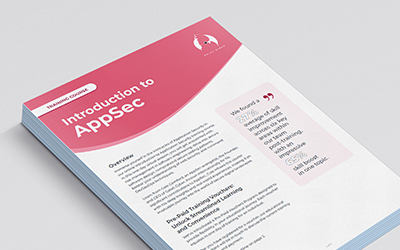The latest Cyber Threat Report from the Australian Signals Directorate (ASD), covering FY 2023, found that 34% of data breaches involved exploiting internet-facing applications. Threat actors achieved exploitation through common vulnerabilities and exposures (CVEs), human misconfiguration of unsecured application programming interfaces, or common bugs and flaws in software. The report also found that threat actors exploited 21% of CVEs within 48 hours of patches or mitigation advice being released.
This figure further supports why I believe Application Security (AppSec) should be common practice for development teams. Proactively addressing vulnerabilities enhances security and prevents your application from becoming another in the list of case studies and statistics. Moreover, it protects the people who use your applications, which, I would argue, is among the highest priorities.
What is an application security assessment?
An application security assessment is a thorough process designed to understand vulnerabilities in your applications and prevent potential threats. It’s a comprehensive evaluation that encompasses several key elements:
- Identifying key threats that pose a risk to the application. External or internal bad actors might exploit vulnerabilities for their own gain.
- Assessing the application’s security architecture to uncover any inherent weaknesses that cyber attackers could exploit.
- Identifying the measures needed to protect the application from these and mitigate risks to the business and customers.
AppSec assessments will use multiple methods to evaluate your application. While automated tools such as Static Application Security Testing (SAST) and Software Composition Analysis (SCA) provide useful insights, a good assessment will use human skills. The types of assessments conducted will include:
- Vulnerability scanning systematically identifies and reports on security weaknesses within the application, offering a broad overview of areas requiring attention.
- Penetration testing actively exploits vulnerabilities in a controlled manner, mimicking the actions of cyber attackers to understand the real-world implications of these weaknesses.
- Code reviews examine the application’s source code for any security flaws, ensuring that the application is secure by design and resilient against future threats.
- Software architecture reviews evaluate the security present in your systems, identify threats and suggest mitigation tactics.
Together, these practices form the backbone of a cybersecurity assessment, providing your organisation with the insights needed to protect applications. Here are a few more reasons to undergo an AppSec assessment this year.
Add consistency to your AppSec practices
Consistency is key to getting AppSec right. Regular assessments are critical for identifying and mitigating security vulnerabilities before malicious actors can exploit them. Completing an assessment this year might be a good idea if it has been a while since your last one.
AppSec assessments should be part of your broader strategy. Consistent AppSec practices lead to a reduction in the overall number of security issues. Adopting a proactive approach to AppSec enables your organisation to significantly reduce the risk of data breaches and other security incidents.
Regular security tests and assessments support your organisation in establishing a baseline of security standards that development teams can adhere to. This consistency helps identify vulnerabilities early and builds a culture of security awareness among developers.
Gain an understanding of your application’s key vulnerabilities
An AppSec assessment will identify the threat actors most likely to target your organisation and attempt to pinpoint the vulnerabilities they might exploit. Bad actors could also be internal personas that might accidentally or intentionally breach your application.
An assessment will then provide recommendations for mitigating these risks, allowing your organisation to make informed decisions about what to resolve first and how you should prevent such attacks moving forward.
An AppSec assessment will also identify the vulnerabilities in your application. An assessment goes beyond surface-level analysis and comprehensively examines your applications to reveal hidden flaws. It does more than simply use automated tools to surface vulnerabilities; it includes skilled people overseeing the process. The insights provided are invaluable for developers and security teams, enabling them to adjust the application’s security posture.
Inform your future AppSec efforts in the SDLC
AppSec assessments will analyse weaknesses in your security practices within the Software Development Life Cycle (SDLC). They scrutinise each stage of the SDLC, from design through deployment to maintenance, to identify areas requiring remediation.
This detailed review leads to the development of well-defined rules for embedding security into the SDLC, guiding the creation of safer applications by pinpointing improvement areas and establishing a blueprint for future security measures. These findings also educate development teams on AppSec best practices.
By embedding security considerations into the company’s culture, AppSec assessments promote a proactive stance towards risk mitigation and foster an environment where security becomes a collective responsibility.
Get an outside perspective on vulnerabilities in your business
Sometimes, external teams overlook vulnerabilities, not out of malicious intent but because they have worked with the code for too long and may not notice anomalies.
Engaging an external party to conduct your AppSec assessment offers a fresh perspective on your company’s security posture. Bringing fresh eyes, different methodologies, and experience from various industries, external assessors can offer new insights and suggest security enhancements. It analyses your security measures from every angle and mirrors an attacker’s diverse approaches. This external perspective can reveal blind spots within your security framework, which internal teams, despite their diligence, might miss due to familiarity with their environment.
Conclusion
AppSec assessments are more than routine and procedural steps; they provide an understanding of your application’s vulnerabilities and analyse the security practices in your SDLC. Development teams that embed security practices into the SDLC can significantly reduce the risk of publishing applications with vulnerabilities. An external perspective on AppSec highlights blind spots in your application’s code or SDLC. These insights can help your development team strengthen security measures in future.
Why choose Galah Cyber to conduct your AppSec assessment?
Our AppSec Advisory Services cover various activities and methodologies to ensure security, reliability and compliance. We identify, assess, and mitigate risks throughout the software development lifecycle and in production environments. Our experts guide you in identifying, prioritising, and addressing vulnerabilities, offering actionable and practical advice. Visit our Advisory Services page for more details.







